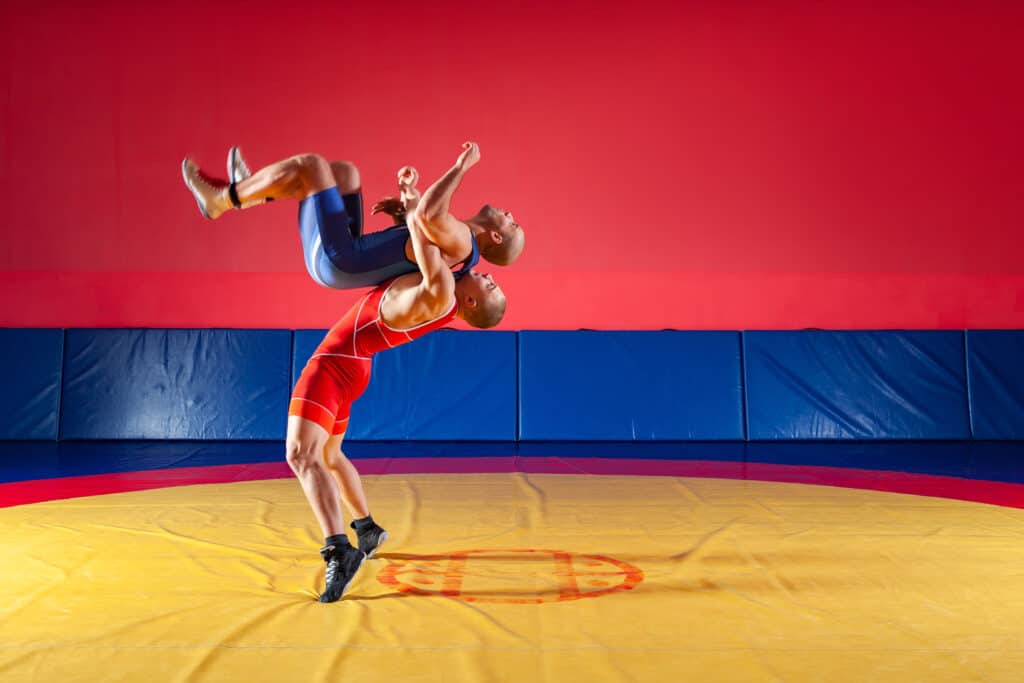
Understanding which moves are allowed could mean the difference between collecting a victory and a loss in high school wrestling. Wrestlers hoping to perfect their techniques may wonder if suplexes are allowed in high school wrestling.
A suplex isn’t allowed in high school wrestling, as it puts wrestlers at risk. If a high school student receiving the suplex lands on their neck, they can suffer severe long-term damage.
Even though suplexes might be allowed in other forms of wrestling such as freestyle wrestling or Greco-roman wrestling, they are illegal in high school wrestling.
Much of this simply has to do with the fact that they have stricter rules to help keep kids safe. Parents would be much less willing to let their kids participate in high school wrestling if it is too dangerous.
So naturally, riskier moves such as the suplex are going looked at more critically when there is a school board and parents looking after the safety of their students and kids.
When answering this question, it’s crucial to define what a suplex is. It’s also essential to discuss folkstyle wrestling and its allowed moves. This way, you can ensure you perform admirably and avoid accidental disqualifications and injuries.
Why a Suplex Isn’t Allowed in High School Wrestling
The suplex move isn’t allowed in high school wrestling, as it puts the opponent at risk of serious neck injury. A suplex is when one wrestler wraps their arms around the midsection of their opponent, then lifts upward and back to flip the opponent onto the mat.
When performed correctly, a suplex should result in a fallen opponent lying on their back. However, this move often has the opponent landing on their upper back, and it’s only too easy for wrestlers to land on their necks when they’re on the receiving end of a suplex.
Some of the most common injuries associated with the suplex move include:
- Spinal fractures
- Cervical sprain
- Concussion
There are several types of suplexes, but all types are inadmissible in high school wrestling due to their ability to cause serious harm.
Understanding the rules of high school wrestling will help keep you and your opponents safer on the mats. In addition, it will help you from becoming disqualified.
High School Wrestling Was Designed To Be Safer
Folkstyle wrestling is a style of wrestling that’s often associated with high school and collegiate sports. It’s primarily a grappling-focused form of wrestling that stems mostly from English catch wrestling matches but also some Native American wrestling styles.
If you are familiar with catch wrestling then you will know that it is quite a brutal grappling art. In catch wrestling, a wrestler would win a match only through a pin or a submission.
Many of these submissions were very painful and brutal. In addition, it also had some very brutal and potentially dangerous takedowns. A suplex would certainly be one of them.
Though catch wrestling was getting popular in the States, it was obvious that making it a sport that would be accepted by schools would be difficult. This is simply because it would be considered too dangerous.
So naturally, they removed the submissions, added a points system, and removed some takedowns such as the suplex.
Rules Of High School Wrestling
In high school wrestling, every match involves two wrestlers that compete against one another for points and overall dominance. While physical prowess is a vital component of folkstyle wrestling, strategy is also involved. Competitors must both overpower and outwit their opponent to win the match.
Each high school wrestling match consists of three rounds. At the start of the first round, competitors are in a neutral position.
This means that the wrestlers are standing upright, facing each other, but not touching. When the match begins, both wrestlers begin attempting to score points and pin the opponent to the mat.
The objective is to pin the opponent, but wrestlers can also win matches by accumulating points. There are several ways to collect points, including performing successful takedowns, gaining control over the opponent, and escaping the opponent’s hold.
High school wrestling prohibits all moves that may cause unnecessary or immediate physical harm. This includes suplexes and some other dangerous takedowns.
However, wrestlers can flip their opponent onto the mat to gain the upper hand and earn points.
What Takedowns Are Allowed in High School Wrestling?
I do not intend this to be an extensive list of all of the takedowns that are allowed in high school wrestling. Instead, it is simply some of the more common takedowns that are allowed in high school wrestling that can replace the use of a suplex.
- Double Leg Takedown: The double leg takedown is probably the most popular takedown in all grappling sports and MMA. This is simply where you take your opponent down by grabbing behind both legs of your opponent.
- Single Leg Takedown: This is when a wrestler wraps their arms or upper body around their opponent’s leg, then lifts and stands, causing the opponent to fall flat against the mat.
- Hip Throw: This is where you grab your opponent’s upper body and bump them over your hips. Unlike the suplex, you are bumping them over your hips instead of over and behind your body. With this move, it is easier to control where your opponent lands.
- Head and Arm Throw: Similar to the hip throw except that you have one arm wrapped around your opponent’s head and the other holding on to their arm.
- Firemans Carry: This takedown is hard to explain on paper instead check out this video from High School Wrestling Matches on Youtube.
Are Suplexes Allowed In Other Forms Of Wrestling?
Folkstyle wrestling and freestyle wrestling are often confused with one another. And while these styles share some commonalities, they’re not identical. Suplexes are allowed in freestyle wrestling and are even rewarded more points than some other takedowns.
Freestyle wrestling is an internationally recognized form of wrestling. When wrestlers compete in the Olympic Games, they practice freestyle wrestling or Greco-Roman Wrestling. Like freestyle wrestling, suplexes are allowed in Greco-roman wrestling as well.
Conclusion
The suplex is when one wrestler wraps their arms around the waist of their opponent and lifts upward while bending backward. This move flips the opponent onto their back, but it can also cause neck injury if performed incorrectly. Consequently, it’s not a legal move in high school wrestling.
High school wrestling follows conservative rules and adheres to a traditional point-scoring system. Competitors can score points by escaping their opponent’s hold, performing a takedown move, or causing their opponent to nearly fall.
